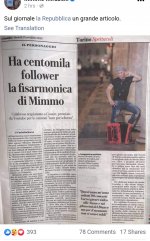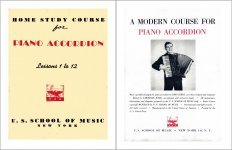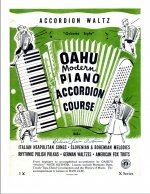I can't speak to what's up with kids these days, and I've never been trendy, but I'm younger than most of the folks on this forum so will throw in my 2 cents as a counterweight.
@AccordionUprising Maybe Bruce can tell us if these are common sentiments among the millennials he's interviewed, or just my own personal idiosyncrasies.
I am suspicious of big fake smiles and showmanship. I can appreciate when the performer and audience are genuinely having a good time.
I dislike virtuosity for its own sake. I can appreciate (and am sometimes moved by) complex and difficult compositions played by skilled musicians but don't often seek it out. Sorry.
I dislike gimmicks like playing the instrument upside down or strapped to your dance partners' back--it might evoke a chuckle but it only serves to reinforce the image of the accordion as a novelty act--neither dignified nor cool.
I dislike most of the videos I see that use MIDI arranger modules or V-Accordions. The Michael Bridges one is okay, but most of what I hear is accordion sounds with too much reverb and non-accordion sounds that are not real enough to be convincing but not electronic enough to pass for an EDM or hip hop beat.
Hearing accordion renditions of pop, rock, or video game songs is an attention-getter but not enough.
In my opinion, the trick to popularizing the accordion is to treat is as a normal instrument, not primarily as a one-man-band. It's a valid niche but it's a limited one. Piano and guitar can be solo instruments, but the solo acts that stay on my playlist are not virtuosos or variety acts, they are singer-songwriters. More to the point, you don't only hear guitar and piano played by solo musicians, or (god forbid) in guitar or piano orchestras! You hear them in all kinds of different combos. I just had a friend my age hear--for the first time--an accordion played in an ensemble with restraint--not too many notes, usually played soft enough to blend into the mix, popping up for fills and solos. He was surprised to realize it was an accordion and wanted to hear more of it!
I grew up with no animus (no opinion at all, really) toward the traditional genres where members of the accordion family are still part of bands. Some I've grown to love (gypsy swing), some I enjoy in moderation (polka, tango). But hearing accordion employed in unusual and edgy ways (Pogues, Beirut, Decemberists, Esteban Jordan) really encouraged me to stick with it and make it my own. Thanks, Accordion Noir.
Price, I think is not that big a deterrent to starting the accordion. I got my first box used for $200US, it served me well. New Chinese boxes are not too expensive either--that was my second accordion, it also served me well.
From the perspective of a parent making their child play the instrument, then yes, it's important for there to be teachers, and rental instruments, and performance opportunities in school or conservatory. I was picking the instrument for fun and not sure I was serious enough to tackle advanced repertoire, or even to pay for lessons. What helped me was seeing youtube videos of young people playing "Amelie" and be able to find a free tutorial so I could do it myself. Is the technique bad? What did I care? They made it look fun and like something I could do. It didn't seem corny and old fashioned like the stuff in my method book.





